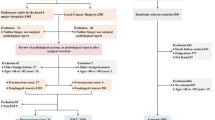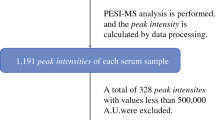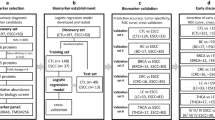Abstract
Objective
Biomarker assay is a noninvasive method for the early detection of esophageal squamous cell carcinoma (ESCC). Searching for new biomarkers with high specificity and sensitivity is very important for the early detection of ESCC. Serum surface-enhanced laser desorption/ionization-time of flight mass spectrometry (SELDI-TOF-MS) is a high throughput technology for identifying cancer biomarkers using drops of sera.
Methods
In this study, 185 serum samples were taken from ESCC patients in a high incidence area and screened by SELDI. A support vector machine (SVM) algorithm was adopted to analyze the samples.
Results
The SVM patterns successfully distinguished ESCC from pre-cancerous lesions (PCLs). Also, types of PCL, including dysplasia (DYS) and basal cell hyperplasia (BCH), and healthy controls (HC) were distinguished with an accuracy of 95.2% (DYS), 96.6% (BCH), and 93.8% (HC), respectively. A marker of 25.1 kDa was identified in the ESCC patterns whose peak intensity was observed to increase significantly during the development of esophageal carcinogenesis, and to decrease obviously after surgery.
Conclusions
We selected five ESCC biomarkers to form a diagnostic pattern which can discriminate among the different stages of esophageal carcinogenesis. This pattern can significantly improve the detection of ESCC.
Similar content being viewed by others
References
Adam, B., Qu, Y., Davis, J.W., Ward, M.D., Clements, M.A., Cazares, L.H., Semmens, O.J., Schellhammer, P.F., Yasui, Y., Ziding, F., et al., 2002. Serum protein fingerprinting coupled with a pattern-matching algorithm distinguishes prostate cancer from benign prostate hyperplasia and healthy men. Cancer Res., 62(13):3609–3614.
Brockmann, J.G., Nottberg, H., Glodny, B., Sprakel, B., Senninger, N., 2000. Analysis of serum CYFRA 21-1 concentrations in patients with esophageal cancer. Anticancer Res., 20(6D):4899–4904.
Felix, K., Fakelman, F., Hartmann, D., Giese, N.A., Gaida, M.M., Schnolzer, M., Flad, T., Buchler, M.W., Werner, J., 2011. Identification of serum proteins involved in pancreatic cancer cachexia. Life Sci., 88(5–6):218–225. [doi:10.1016/j.lfs.2010.11.011]
Handy, B., 2009. The clinical utility of tumor markers. Labmedicine, 40(2):99–103.
Helgason, H.H., Engwegen, J., Zapatka, M., Vincent, A., Cats, A., Boot, H., Beijnen, J.H., Schellens, J.H., 2010. Identification of serum proteins as prognostic and predictive markers of colorectal cancer using surface enhanced laser desorption ionization-time of flight mass spectrometry. Oncol. Rep., 24(1):57–64. [doi:10.3892/or_00000828]
Høgdall, E., Fung, E.T., Christensen, I.J., Yip, C., Nedergaard, L., Engelholm, S.A., Risum, S., Petri, A.L., Lundvall, L., Lomas, L., et al., 2010. Proteomic biomarkers for overall and progression-free survival in ovarian cancer patients. Proteom. Clin. Appl., 4(12):940–952. [doi:10.1002/prca.200900171]
Hu, Y., Zhang, S.Z., Yu, J.K., Liu, J., Zheng, S., 2005. SELDI-TOF-MS: the proteomics and bioinformatics approaches in the diagnosis of breast cancer. Breast, 14(4): 250–255. [doi:10.1016/j.breast.2005.01.008]
Kawaguchi, H., Ohno, S., Miyazaki, M., Hashimoto, K., Egashira, A., Saeki, H., Watanabe, M., Sugimachi, K., 2000. CYFRA 21-1 determination in patients with esophageal squamous cell carcinoma: clinical utility for detection of recurrences. Cancer, 89(7):1413–1417. [doi:10.1002/1097-0142(20001001)89:7<1413::AID-CNCR1>3.0.C O;2-I]
Klade, C.S., Voss, T., Krysteck, E., Ahorn, H., Zatloukal, K., Pummer, K., Adolf, G.R., 2001. Identification of tumor antigens in renal cell carcinoma by serological proteome analysis. Proteomics, 1(7):890–898. [doi:10.1002/1615-9861(200107)1:7<890::AID-PROT890>3.3.CO;2-Q]
Kosugi, S., Nishimaki, T., Kanda, T., Nakagawa, S., Ohashi, M., Hatakeyama, K., 2004. Clinical significance of serum carcinoembryonic antigen, carbohydrate antigen 19-9, and squamous cell carcinoma antigen levels in esophageal cancer patients. World J. Surg., 28(7):680–685. [doi:10.1007/s00268-004-6865-y]
Liu, J., Zheng, S., Yu, J.K., Zhang, J.M., Chen, Z., 2005. Serum protein fingerprinting coupled with artificial neural network distinguishes glioma from healthy population or brain benign tumor. J. Zhejiang Univ. Sci., 6B(1):4–10. [doi:10.1631/jzus.2005.B0004]
Lu, J.B., Yang, W.X., Zu, S.K., Chang, Q.L., Sun, X.B., Lu, W.Q., Quan, P.L., 1988. Cancer mortality and mortality trends in Henan, China, 1974-1985. Cancer Detect Prev., 13:167–173.
Lu, J.B., Sun, X.B., Dai, D.X., Zu, S.K., Chang, Q.L., 2002. Cancer mortality and mortality trends in Henan Province, China, 1974–1999. Int. J. Cancer, 13:238.
Nakamura, T., Ide, H., Eguchi, R., Hayashi, K., Takasaki, K., Watanabe, S., 1998. CYFRA 21-1 as a tumor marker for squamous cell carcinoma of the esophagus. Dis. Esophagus., 11(1):35–39.
Okamoto, A., Yamamoto, H., Imai, A., Hatakeyama, S., Iwabuchi, I., Yoneyama, T., Hashimoto, Y., Kote, T., Kamimura, N., Mori, K., et al., 2009. Protein profiling of post-prostatic massage urine specimens by surface-enhanced laser desorption/ionization time-of-flight mass spectrometry to discriminate between prostate cancer and benign lesions. Oncol. Rep., 21(1):73–79. [doi:10.3892/or_00000191]
Opstal-van Winden, A.W., Krop, E.J., Karedal, M.H., Gast, M.C., Lindh, C.H., Jeppsson, M.C., Jonsson, B.A.G., Grobbee, D.E., Peeters, P.H.M., Beijnen, J.H., et al., 2011. Searching for early breast cancer biomarkers by serum protein profiling of pre-diagnostic serum; a nested case-control study. BMC Cancer, 11:381. [doi:10.1186/1471-2407-11-381]
Parenti, A., Porzionato, A., Pizzi, S., Guzzardo, V., Fassina, G., Macchi, V., Ninfo, V., de Caro, R., 2007. Expression pattern of squamous cell carcinoma antigen in oesophageal dysplasia and squamous cell carcinoma. Histol. Histopathol., 22(9):989–995.
Parkin, D.M., Bray, F., Ferlay, J., Pisani, P., 2005. Global cancer statistics, 2002. CA Cancer J. Clin., 55(2):74–108. [doi:10.3322/canjclin.55.2.74]
Petricoin, E.F., Liotta, L.A., 2004. SELDI-TOF-based serum proteomic pattern diagnostics for early detection of cancer. Curr. Opin. Biotech., 15(1):24–30. [doi:10.1016/j.copbio.2004.01.005]
Rai, A., Zhang, Z., Rosenzweig, J., Shih, L., Pham, T., Fung, E., Sokoll, L., Chan, D., 2002. Proteomic approaches to tumor marker discovery. Arch. Pathol. Lab. Med., 126(12): 1518–1526.
Rathinam, S., Ward, D.G., James, N.D., Rajesh, P.B., 2011. Proteomic analysis of resectable non-small cell lung cancer: post-resection serum samples may be useful in identifying potential markers. Interact. Cardiovasc. Thorac. Surg., 13(1):3–6. [doi:10.1510/icvts.2010.260.166]
Tanaka, K., Yano, M., Motoori, M., Kishi, K., Miyashiro, I., Shingai, T., Gotoh, K., Noura, S., Takahashi, H., Ohue, M., et al., 2010. CEA-antigen and SCC-antigen mRNA expression in peripheral blood predict hematogenous recurrence after resection in patients with esophageal cancer. Ann. Surg. Oncol., 17(10):2779–2786. [doi:10.1245/s10434-010-1075-3]
Tang, K.L., Li, T.H., Xiong, W.W., Chen, K., 2010. Ovarian cancer classification based on dimensionality reduction for SELDI-TOF data. BMC Bioinformatics, 11:109. [doi:10.1186/1471-2105-11-109]
Vapnik, V., 1995. The Nature of Statistical Learning Theory. Springer-Verlag, New York.
Wang, L.D., Zheng, S., Liu, B., Zhou, J.X., Li, Y.J., Li, J.X., 2003. CYP1A1, GSTs and mEH polymorphisms and susceptibility to esophageal carcinoma: study of population from a high-incidence area in north China. World J. Gastroenterol., 9(7):1394–1397.
Yamamoto-Ishikawa, K., Suzuki, H., Nezu, M., Kamiya, N., Imamoto, T., Komiya, A., Sogawa, K., Tomonaga, T., Nomura, F., Ichikawa, T., 2009. The isolation and identification of apolipoprotein C-I in hormone-refractory prostate cancer using surface-enhanced laser desorption/ionization time-of-flight mass spectrometry. Asian J. Androl., 11(3):299–307. [doi:10.1038/aja.2008.38]
Yang, C.S., 1980. Research on esophageal cancer in China: a review. Cancer Res., 40(8):2633–2644.
Yilmaz, O., Eroglu, A., Dag, E., Karaoglanoglu, N., Yilmaz, A., 2006. Serum levels of IGF-I and IGFBP-III and their relation with carcinoembryonic antigen and carbohydrate antigen 19-9 in cases of esophageal cancer. Int. J. Clin. Pract., 60(12):1604–1608. [doi:10.1111/j.1742-1241.2006.00854.x]
Yu, J.K., Chen, Y.D., Zheng, S., 2004. An integrated approach to the detection of colorectal cancer utilizing proteomics and bioinformatics. World J. Gastroenterol., 10(21): 3127–3131.
Author information
Authors and Affiliations
Corresponding author
Additional information
Project supported by the National Natural Science Foundation of China (No. 30901731) and the Fundamental Research Funds for the Central Universities (No. 2012FZA7004), China
Rights and permissions
About this article
Cite this article
Zhai, Xh., Yu, Jk., Lin, C. et al. Combining proteomics, serum biomarkers and bioinformatics to discriminate between esophageal squamous cell carcinoma and pre-cancerous lesion. J. Zhejiang Univ. Sci. B 13, 964–971 (2012). https://doi.org/10.1631/jzus.B1200066
Received:
Accepted:
Published:
Issue Date:
DOI: https://doi.org/10.1631/jzus.B1200066
Key words
- Biomarker
- Esophageal squamous cell carcinoma
- Surface-enhanced laser desorption/ionization
- Support vector machine




